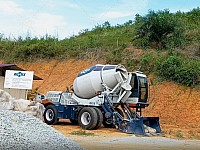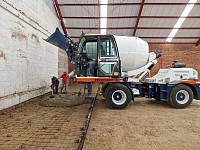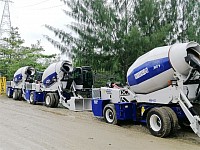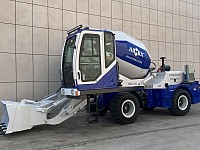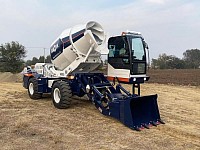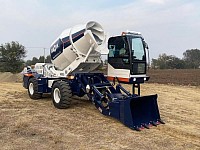Share Reliable Concrete Mixer Features, Applications, Price
Navigating Price Fluctuations in Concrete Mixer Purchases
The construction industry in the Philippines witnesses frequent price fluctuations in concrete mixers. Builders often face challenges in managing costs while aiming for quality and efficiency. Understanding market dynamics, especially with self-loading mixers, is crucial for making informed purchasing decisions. This article explores strategies to navigate these price changes effectively.
Understanding Concrete Mixer Price Dynamics in the Philippines
Concrete mixer prices in the Philippines can change due to various factors. Supply chain issues, economic conditions, and technological advancements are key influences. Builders should understand these factors to make better purchasing choices. Let’s delve into how each factor impacts mixer pricing.
Supply Chain Challenges
Supply chain disruptions can cause price hikes in mixers. Import restrictions or delays often lead to increased costs. Builders need to plan purchases strategically, considering potential supply chain issues. Staying informed about global supply trends helps mitigate unexpected price changes.
Economic Conditions
Economic fluctuations directly affect concrete mixer price Philippines. Inflation and currency exchange rates can alter costs significantly. Builders should keep an eye on economic indicators that influence pricing. Adapting to these changes ensures budget adherence and project success.
Technological Advancements
Technological innovations can impact prices positively or negatively. Advanced features in self-loading mixers may demand higher investment. Builders should evaluate the necessity of such features for their projects. Investing in technology enhances productivity, potentially offsetting initial costs.
The Value of Self-Loading Concrete Mixers
Self-loading concrete mixers offer numerous advantages. They streamline operations, reduce labor costs, and boost efficiency. Understanding their value helps builders make informed purchasing decisions amidst price fluctuations. Let’s explore the benefits of self-loading mixers in detail.
Operational Efficiency
Self-loading mixers automate loading, mixing, and discharging tasks. This automation reduces manual labor, improving project timelines. Builders can complete tasks faster, enhancing overall efficiency. This operational advantage often justifies the initial investment, despite price changes.
Cost Reduction
Reducing labor costs is a significant benefit of the self loading concrete mixer with pump. These mixers minimize the need for additional workforce, saving money over time. Builders see long-term savings, making them a cost-effective choice despite fluctuating prices.
Enhanced Mobility
Self-loading mixers are designed for easy maneuverability. They operate efficiently in varied terrains, making them versatile. Builders appreciate their adaptability across different project environments. This flexibility adds value, especially when prices fluctuate.
Strategies to Navigate Price Fluctuations
Dealing with price fluctuations requires strategic planning. Builders should explore financing options, leverage bulk purchases, and maintain supplier relationships. These strategies help manage costs effectively amidst changing prices.
Exploring Financing Options
Financing options can ease the financial burden of purchasing mixers. Builders might consider loans or leasing arrangements to manage cash flow. Flexible payment plans offer a practical solution during price hikes.
Leveraging Bulk Purchases
Bulk purchasing can provide cost advantages. Builders should negotiate with suppliers for discounts when buying multiple units. This strategy works well in managing budget constraints and ensuring cost-effectiveness.
Maintaining Supplier Relationships
Strong supplier relationships can lead to better deals. Communicating budget constraints and project needs clearly helps in negotiations. Suppliers often provide favorable pricing to trusted clients, aiding in managing price fluctuations.
Conclusion
Navigating price fluctuations in concrete mixer purchases requires strategic insight and planning. Builders must understand market dynamics, especially in the Philippines, and leverage self-loading mixers' advantages. By exploring financing options, bulk purchases, and supplier relationships, they can manage costs effectively. Staying informed and adaptable ensures successful project outcomes and financial stability.
Localized Production: The Potential of Concrete Mixer Manufacturing
Localized production is gaining traction in the construction industry. Concrete mixer manufacturing is at the forefront of this shift. Local production offers flexibility, cost savings, and enhances community development.
The Benefits of Localized Concrete Mixer Manufacturing
Localized manufacturing reduces transportation costs. Producing mixers close to home minimizes shipping expenses and delivery times. This efficiency supports faster project completion.
Self loading concrete mixers and small mixers benefit from local production. Manufacturers can quickly adapt to market demands and trends. This adaptability ensures the availability of advanced technology.
Moreover, local production lowers small concrete mixer price. It reduces import costs and supports competitive pricing. Contractors benefit from affordable options without compromising quality.
Self Loading Concrete Mixers: Innovation through Local Production
Self loading concrete mixers automate loading and mixing processes. Local manufacturing enhances their innovation and accessibility.
Manufacturers tailor self loading mixer concrete to regional needs. This customization supports diverse project requirements. Contractors benefit from efficient equipment designed for local challenges.
Additionally, local production fosters technological advancements. Manufacturers invest in research and development to improve mixer features. This innovation boosts project efficiency and success.
Cost-Efficiency in Localized Small Concrete Mixer Production
Small concrete mixer production offers cost-effective solutions. Local manufacturing supports competitive small concrete mixer prices.
Contractors access affordable mixers without compromising quality. Local production reduces import costs and aligns with budget constraints. This affordability supports diverse projects and tight budgets.
Moreover, local production simplifies logistics. Contractors avoid long shipping times and complex import procedures. This convenience enhances project efficiency and focus.
Community Development through Localized Manufacturing
Localized mixer production promotes community growth. It creates jobs and supports local economies.
Manufacturers hire local talent for production processes. This employment boosts community development and stability. It aligns with sustainable growth and social responsibility.
Additionally, local production fosters collaboration. Manufacturers work with local businesses for materials and services. This partnership strengthens community ties and supports shared success.
Implementing Localized Manufacturing Strategies
Implementing localized production requires strategic planning. Manufacturers must assess market needs and resources. Identifying opportunities helps in effective strategy formulation.
Investing in technology is crucial for successful localization. Manufacturers must prioritize research and development. This investment supports innovation and market competitiveness.
Moreover, collaboration with industry partners fosters effective integration. Sourcing reliable suppliers aligns with industry standards. This collaboration supports responsible manufacturing and project success.
Future Trends in Localized Concrete Mixer Manufacturing
Technological advancements continue to shape manufacturing practices. Innovative processes offer exciting possibilities for localized mixer production. These developments enhance efficiency and support sustainability.
Predictive analytics play a significant role in future manufacturing trends. Analyzing data helps identify opportunities and challenges. This foresight enables proactive adjustments and continuous improvements.
Sustainability will remain a key focus in manufacturing strategies. Eco-friendly practices align with industry trends. Manufacturers must prioritize sustainable solutions for long-term success.
Conclusion
Localized production significantly impacts concrete mixer manufacturing. Self loading and small mixers offer flexible and cost-effective solutions.
By implementing localized strategies, manufacturers enhance operational efficiency and community development. These solutions support project success and economic growth.
Staying informed about manufacturing trends supports resilience and innovation. Embracing local production ensures long-term success in a competitive market.
Vibration Analysis and Damping Solutions for Mixer Drive Systems
Concrete mixer drive systems experience vibrations during operations. Analyzing these vibrations is crucial for ensuring efficiency and longevity. Implementing effective damping solutions reduces wear and enhances performance.
Understanding Vibration in Mixer Drive Systems
Vibration results from the movement and rotation within mixers. It affects system components and can lead to inefficiencies. Identifying vibration sources is essential for effective management and reduction.
Self loading concrete mixer faces specific vibration challenges. Their automated operations involve complex movements. Analyzing vibrations in these mixers ensures smoother operations and reduced wear.
Mobile concrete mixers operate in diverse environments. Their mobility subjects them to varied vibration patterns. Effective analysis helps create tailored damping solutions for reliability.
Methods of Vibration Analysis
Monitoring systems track vibration levels in real-time. These systems provide valuable data for analysis. Contractors use this information to identify and address vibration issues.
Frequency analysis identifies dominant vibration frequencies. This method helps pinpoint problematic frequencies. Addressing these can lead to reduced wear and improved system performance.
Visual inspections detect physical signs of vibration damage. These inspections complement technical analysis. Regular checks help spot issues early and prevent costly repairs.
Implementing Damping Solutions for Mixer Drive Systems
Damping solutions minimize vibrations and enhance system longevity. Contractors must select appropriate materials and designs. Understanding system requirements ensures effective implementation.
Rubber mounts absorb vibrations effectively. They offer a cost-effective damping solution. Contractors often use them for basic vibration management.
Hydraulic dampers provide advanced vibration control. They adapt to varied operational conditions. This adaptability makes them suitable for mobile concrete mixers.
Role of Different Mixers in Vibration Management
Self loading mixers benefit from comprehensive damping solutions. Their complex operations require consistent vibration control. Choosing effective solutions ensures smooth operations and equipment longevity.
The mobile concrete mixer needs adaptable damping strategies. Their mobility demands flexible solutions. Contractors focus on quick assessments and timely interventions to maintain reliability.
Future Trends in Vibration Analysis and Damping Solutions
Technological advancements continue to shape vibration management strategies. Innovative designs offer exciting possibilities for system efficiency. These developments enhance reliability and support operational goals.
Predictive analytics play a significant role in future trends. Analyzing data helps identify opportunities and challenges. This foresight enables proactive adjustments and continuous improvements.
Sustainability will remain a key focus in vibration management. Eco-friendly solutions align with industry trends. Contractors must prioritize sustainable practices for long-term success.
Conclusion
Effective vibration analysis and damping solutions are crucial for mixer drive systems. Different mixers support efficient strategies with tailored approaches.
By implementing strategic solutions, contractors enhance operational efficiency and reduce wear. These solutions support project success and global construction goals.
Staying informed about vibration trends supports growth and resilience. Embracing innovation ensures long-term success in a competitive market.
Seizing Opportunities with Damping Solutions
Effective damping solutions open new market opportunities. Manufacturers can tap into emerging markets by focusing on regional needs. Understanding local construction trends helps cater to specific project requirements.
Global infrastructure development drives demand for reliable solutions. As countries invest in roads, bridges, and buildings, optimized damping systems become essential. Strategic approaches meet these needs by offering reliable and adaptable solutions.
Moreover, urbanization fuels growth in damping strategies. Cities require quick and efficient construction solutions. Effective damping systems provide the reliability needed for urban development projects.
Contractors must adapt to these market changes. Staying updated with global trends ensures competitiveness and growth. By leveraging damping technology capabilities, contractors can seize new opportunities and thrive in evolving markets.
Noise Reduction Technologies for Concrete Mixing and Producing
Concrete mixing and producing are essential in construction. However, noise pollution can disrupt work environments and communities. Implementing noise reduction technologies improves operations and minimizes disturbances.
Understanding Noise in Concrete Mixing
Concrete mixers generate significant noise during operation. This noise impacts worker health and surrounding areas. Reducing noise levels enhances workplace safety and community relations.
Self loading concrete mixers operate automatically and can be particularly noisy. Implementing noise reduction solutions in the self loading cement mixer is crucial. These technologies enhance productivity and reduce environmental impact.
Mobile concrete mixers work in various settings and transport concrete over distances. Their noise can disrupt numerous locations. Effective noise reduction strategies ensure smoother operations and community acceptance.
Key Noise Reduction Technologies
Sound barriers block noise from spreading. They are essential for noisy mixer operations. Contractors use them to protect workers and nearby communities.
Vibration damping materials reduce noise inside mixers. These materials minimize sound production at the source. Applying them helps maintain quieter operations.
Acoustic enclosures surround noisy equipment. They contain sound and prevent it from reaching workers and the environment. These enclosures are vital for maintaining low noise levels.
Implementing Noise Reduction Strategies
Effective implementation requires assessing mixer specifications and operational needs. Tailoring solutions to specific requirements ensures optimal noise reduction.
Regular maintenance is key to sustaining noise reduction. Routine checks identify wear in sound barriers and damping materials. Timely interventions maintain quieter operations.
Training operators on noise reduction practices is essential. Understanding equipment and technology helps operators minimize noise output. This knowledge supports efficient and quiet mixer operation.
Noise Reduction in Different Mixer Types
Self loading mixers benefit from comprehensive noise reduction strategies. Their automated processes demand consistent noise control solutions. Choosing effective technologies ensures quieter operations.
The mobile concrete mixer requires adaptable noise reduction methods. Their diverse environments need flexible solutions. Contractors focus on quick assessments and timely interventions to maintain low noise levels.
Future Trends in Noise Reduction Technologies
Technological advancements continue to shape noise reduction strategies. Innovative designs offer exciting possibilities for quieter operations. These developments enhance workplace safety and community relations.
Predictive maintenance plays a significant role in future trends. Analyzing data helps identify noise sources and solutions. This foresight enables proactive adjustments and continuous improvements.
Sustainability remains a key focus in noise reduction. Eco-friendly designs align with industry trends. Contractors prioritize sustainable practices for long-term success.
Conclusion
Noise reduction technologies are crucial for effective concrete mixing and producing. Different mixers support efficient strategies with tailored approaches.
By implementing strategic noise reduction solutions, contractors enhance productivity and reduce environmental impact. These solutions support project success and community acceptance.
Staying informed about noise reduction trends supports growth and resilience. Embracing innovation ensures long-term success in a competitive market.
Seizing Opportunities with Noise Reduction Technologies
Effective noise reduction solutions open new market opportunities. Manufacturers can tap into emerging markets by focusing on regional needs. Understanding local construction trends helps cater to specific project requirements.
Global infrastructure development drives demand for reliable noise reduction solutions. As countries invest in roads, bridges, and buildings, optimized noise control systems become essential. Strategic approaches meet these needs by offering reliable and adaptable solutions.
Moreover, urbanization fuels growth in noise reduction strategies. Cities require quick and efficient construction solutions. Effective noise reduction systems provide the quiet needed for urban development projects.
Contractors must adapt to these market changes. Staying updated with global trends ensures competitiveness and growth. By leveraging noise reduction technology capabilities, contractors can seize new opportunities and thrive in evolving markets.
Understanding the Cost Breakdown of Concrete Mixers in Nigeria’s Market
Concrete mixers are essential tools in Nigeria’s construction industry. Knowing their cost breakdown can help buyers make informed decisions. This article explores the components that influence pricing, focusing on self-loading mixers and their role in Nigeria.
Key Components Affecting Concrete Mixer Prices
Several factors affect concrete mixer price in Nigeria. Major influences include manufacturing costs, technology integration, and market demand. Understanding these elements helps buyers navigate the market effectively.
Manufacturing Costs
Manufacturing costs play a significant role in pricing mixers. These costs include raw materials, labor, and production processes. Steel, fuel, and other essential materials contribute significantly to the final price.
Technological Integration
Technology impacts mixer prices considerably. Advanced features like self-loading capabilities increase costs. These features offer efficiency and convenience, justifying their higher price tag.
Market Demand
Market demand influences pricing trends. High demand for construction projects can drive up mixer prices. Conversely, an oversupply can lead to price reductions. Buyers should monitor these trends for strategic purchasing.
Exploring Self-Loading Concrete Mixers
Self-loading mixers automate the mixing process. They combine loading, mixing, and unloading in one machine. This technology of self loading concrete mixer reduces labor costs and enhances productivity. However, it often results in a higher purchase price.
Benefits of Self-Loading Mixers
Self-loading mixers offer numerous advantages. They streamline operations, reduce labor needs, and improve efficiency. These benefits can lead to long-term cost savings, despite the initial investment.
Cost Implications
The advanced technology in self-loading mixers affects their pricing. Buyers must evaluate the long-term benefits against the upfront costs. Understanding these implications helps in making informed purchasing decisions.
Concrete Mixer Prices in Nigeria
Nigeria’s concrete mixer prices vary based on several factors. Brand reputation, technological features, and capacity significantly influence pricing. Buyers should consider these aspects when evaluating their options.
Brand and Technology Impact
Reputable brands often charge premium prices. Their products offer reliability and advanced features. Buyers should consider the value these brands provide when assessing costs.
Capacity and Project Needs
Mixers with larger capacities generally cost more. They handle bigger projects efficiently, justifying their higher price. Buyers must assess their project requirements to choose the right capacity, considering future price changes.
Strategies for Managing Costs
Buyers can employ several strategies to manage costs effectively. Conducting thorough research, negotiating with suppliers, and timing purchases are key tactics. These approaches help minimize expenses and maximize investment returns.
Conducting Thorough Research
Research provides insights into market conditions and price variations. Comparing prices from different manufacturers helps buyers make informed decisions. This approach can lead to significant long-term savings.
Negotiating with Suppliers
Effective negotiation can result in better deals. Buyers should engage suppliers in discussions to negotiate favorable terms. Successful negotiation often leads to improved purchasing conditions and reduced costs.
Conclusion
Understanding the cost breakdown of concrete mixers in Nigeria’s market is crucial for informed purchasing. By analyzing factors like manufacturing costs, technology, and market demand, buyers can optimize their investments. Self-loading mixers offer significant benefits but require careful consideration due to their higher prices. Employing strategies like research and negotiation further enhances cost-effectiveness. Staying informed about market conditions ensures buyers remain competitive and efficient in their projects.
Nigeria’s construction industry continues to evolve, making it essential to keep track of technological advancements and market shifts. By adopting a strategic approach, buyers can leverage these insights to secure the best value for their investments and contribute to successful construction outcomes across the country.
Variable Frequency Drive Technology in Concrete Mixers
Concrete mixers are indispensable tools in the construction industry. They ensure efficient mixing and delivery of concrete. Innovative technology is transforming these machines. Variable Frequency Drive (VFD) technology is one such advancement. It enhances the performance and efficiency of concrete mixers. This article explores the impact of VFD technology on self loading, mobile, and small concrete mixers.
Understanding Variable Frequency Drive Technology
Variable Frequency Drive technology controls motor speed and torque. It adjusts the frequency and voltage supplied to the motor. This results in improved energy efficiency and performance.
VFD technology in concrete mixers allows precise control of mixing speeds. This is crucial for achieving the desired concrete consistency. Self loading concrete mixers benefit from this precision. It enhances their efficiency and reduces operational costs. Mobile concrete mixers gain flexibility in various site conditions. Small concrete mixers enjoy increased efficiency and reduced energy consumption.
Benefits of VFD Technology in Concrete Mixers
VFD technology offers several benefits to concrete mixers. It improves energy efficiency significantly. By adjusting motor speeds, it reduces energy consumption. This leads to lower operational costs.
VFD technology also extends the lifespan of mixer components. By reducing mechanical stress, it minimizes wear and tear. This results in lower maintenance costs and downtime. Self loading concrete mixer prices might reflect these savings. Mobile concrete mixers benefit from enhanced adaptability and performance. Small concrete mixers enjoy improved precision and control.
Enhanced Control and Precision
VFD technology provides enhanced control over mixing processes. Operators can adjust speed settings to suit different materials. This ensures optimal mixing and consistency.
Better control translates to improved concrete quality. It allows operators to adapt to varying project requirements. The self loading truck mixer can benefit from this flexibility. Mobile concrete mixers enjoy consistent performance in diverse conditions. Small concrete mixers achieve precision in smaller batches.
Impact on Self Loading Concrete Mixers
Self loading concrete mixers gain significantly from VFD technology. It enhances their automation features and efficiency. Operators can control mixing speeds with precision.
This flexibility leads to better concrete quality and reduced waste. VFD technology also optimizes fuel consumption, lowering operational costs. The self loading concrete mixer price might reflect these long-term savings. Enhanced efficiency makes these mixers valuable assets on construction sites.
Advantages for Mobile and Small Concrete Mixers
Mobile concrete mixers benefit from VFD technology’s adaptability. They handle diverse site conditions with ease. VFD technology ensures consistent performance and quality.
Small concrete mixer machine gains precision and control. These mixers achieve accurate mixing in smaller batches. This results in reduced material wastage and improved project outcomes. VFD technology enhances their efficiency and versatility.
Challenges and Considerations
Implementing VFD technology in mixers presents challenges. Initial costs and installation complexity require consideration. However, the long-term benefits outweigh these challenges.
Proper training is essential for operators to utilize VFD technology effectively. Maintenance requirements should be understood for optimal performance. Despite these challenges, VFD technology offers significant advantages. It enhances efficiency and performance across various mixer types.
Conclusion
Variable Frequency Drive technology revolutionizes concrete mixers. It improves energy efficiency, control, and performance. Self loading, mobile, and small concrete mixers benefit significantly. VFD technology reduces operational costs and enhances concrete quality. Its adaptability makes mixers valuable assets in diverse projects. Despite initial challenges, the benefits justify VFD implementation. Embracing this technology ensures a competitive edge in the construction industry. Owners and operators gain long-term value and efficiency.
Innovative Financing Options to Manage Concrete Mixer Costs
Concrete mixers are essential for construction projects, but their costs can be challenging to manage. Innovative financing options can help reduce financial burdens. This article explores financing strategies for self-loading concrete mixers and examines pricing trends in the Philippines.
Understanding Concrete Mixer Costs
Concrete mixers come in various types, each with different price points. The self-loading concrete mixer offers automation and efficiency, often leading to higher initial costs. Understanding these costs helps buyers plan their budgets effectively.
Initial Investment
Purchasing a concrete mixer requires a substantial upfront investment. Self-loading mixers, with their advanced features, may require higher initial expenditure. Buyers should evaluate their project needs and budget constraints before making a purchase.
Maintenance and Operating Costs
Mixers incur ongoing costs, including maintenance and operation. Regular upkeep ensures optimal performance and longevity, adding to overall expenses. Buyers must factor these costs into their financial planning.
Market Price Fluctuations
Prices can fluctuate based on market dynamics, affecting overall costs. Buyers should stay informed about trends and adjust their financial strategies accordingly. Understanding these fluctuations is crucial for effective budgeting.
Innovative Financing Options
Financing solutions offer opportunities to manage concrete mixer costs effectively. Exploring these options can alleviate financial pressures and enhance purchasing power.
Leasing Arrangements
Leasing provides an alternative to outright purchase. It allows buyers to pay for mixers over time, reducing initial financial burdens. Leasing can be a cost-effective solution for projects with limited budgets.
Installment Plans
Installment plans enable buyers to spread payments over a defined period. This method eases cash flow constraints and allows for better financial planning. Installment plans often come with flexible terms tailored to buyer needs.
Equipment Financing Loans
Financial institutions offer loans specifically for equipment purchases. These loans cater to buyers looking to invest in high-cost items like self-loading mixers. Equipment financing provides access to necessary machinery without immediate full payment.
Concrete Mixer Prices in the Philippines
The concrete mixer market in the Philippines presents unique pricing challenges and opportunities. Understanding local trends helps buyers make informed decisions.
Local Economic Impact
The economy influences concrete mixer price Philippines through factors like inflation and currency exchange rates. Economic stability can lead to predictable pricing, while fluctuations may cause price volatility.
Demand from Infrastructure Projects
Ongoing infrastructure projects drive demand for concrete mixers, impacting prices. Increased demand can lead to higher prices due to limited supply. Buyers should consider these factors when planning purchases.
Import and Export Challenges
Trade policies affect mixer prices through import restrictions and export duties. Changes in these policies can impact costs, especially for imported components. Staying informed about these factors is essential for effective financial planning.
Strategies for Managing Mixer Costs
Implementing strategic methods helps buyers manage concrete mixer costs effectively. Research, negotiation, and timing are key tactics for balancing quality and affordability.
Conduct Thorough Market Research
Researching suppliers and comparing prices is crucial. Buyers should evaluate different manufacturers and models to find the best deal. This approach helps identify competitive pricing and reliable suppliers.
Negotiate Favorable Terms
Negotiation can lead to better deals. Engaging suppliers in discussions helps secure favorable terms. Successful negotiation often results in improved purchasing conditions and reduced costs.
Time Purchases Strategically
Timing influences mixer pricing significantly. Buying during off-peak seasons might result in better prices. Monitoring market trends allows buyers to identify optimal times for purchases, ensuring cost-effectiveness.
Conclusion
Managing concrete mixer costs requires understanding various factors, including initial investment, maintenance, and market fluctuations. Innovative financing options, such as leasing and installment plans, offer viable solutions. Exploring local trends in the Philippines provides valuable insights for buyers. By employing strategic methods, buyers can enhance decision-making and secure competitive, cost-effective purchases.
Understanding these dynamics is essential for successful construction projects. By leveraging these insights, buyers can ensure their investments meet both budgetary and quality expectations. Strategic planning and market analysis foster growth and development, contributing to successful construction outcomes in the Philippines.
Self-Diagnosing Hydraulic Systems in Concrete Mixers: Real-Time Failure Prediction
The construction industry constantly seeks innovation to enhance efficiency and reduce downtime. Self-diagnosing hydraulic systems in concrete mixers offer a groundbreaking solution. These systems enable real-time failure prediction, ensuring smoother operations. This article explores the role of self-diagnosing systems in the concrete self loading mixer, mobile concrete mixers, and hydraulic concrete mixers. We aim to provide valuable insights for customers looking to adopt advanced technology in their construction projects.
Understanding Self-Diagnosing Hydraulic Systems
Self-diagnosing hydraulic systems monitor the health of hydraulic components. They use sensors and advanced algorithms to detect potential issues before they cause failures. This proactive approach reduces downtime and maintenance costs.
The system continuously analyzes data and identifies anomalies in real-time. When a potential issue arises, it alerts operators, allowing them to take timely action. This technology enhances the reliability and performance of concrete mixers. Understanding its benefits helps operators make informed decisions.
Benefits of Real-Time Failure Prediction
Real-time failure prediction offers significant advantages for concrete mixer operators. It minimizes unexpected breakdowns and extends equipment lifespan.
By identifying potential issues early, operators can schedule maintenance during convenient times. This reduces costly downtime and increases operational efficiency. Real-time failure prediction also enhances safety by preventing catastrophic failures. These benefits are crucial for maintaining a competitive edge in the construction industry.
Applications in Self Loading Concrete Mixers
Self loading concrete mixers integrate mixing, loading, and transport functions. They benefit significantly from self-diagnosing hydraulic systems.
These systems monitor hydraulic components, ensuring consistent performance and reliability. They reduce maintenance needs and optimize project timelines. Self loading mixers equipped with self-diagnosing systems meet stringent industry standards. They offer reliable and efficient solutions for complex projects.
Advantages for Mobile Concrete Mixers
The mobile concrete mixer for sale provides flexibility and adaptability for diverse construction sites. Self-diagnosing hydraulic systems enhance their performance and reliability.
These systems detect potential hydraulic issues early, ensuring uninterrupted operation. They minimize maintenance costs and improve equipment lifespan. By adopting self-diagnosing technology, mobile mixers deliver efficient and cost-effective performance. This guarantees successful project outcomes and boosts customer confidence.
Enhancements in Hydraulic Concrete Mixers
Hydraulic concrete mixers rely heavily on hydraulic systems for operation. Self-diagnosing technology ensures their hydraulic components meet high-quality standards.
These systems improve reliability and reduce the risk of unexpected failures. They ensure uniform distribution of concrete components, enhancing structural integrity. Hydraulic mixers with self-diagnosing systems offer efficient solutions for demanding environments. They meet diverse customer needs and expectations.
Implementing Self-Diagnosing Systems in Concrete Mixers
Implementing self-diagnosing systems requires strategic planning and investment. Companies should ensure their equipment supports this advanced technology.
Operators must understand the benefits of real-time failure prediction for hydraulic systems. Proper training and maintenance optimize system performance. By addressing these strategies, companies enhance mixer reliability and longevity. This ensures customer satisfaction and successful project outcomes.
Future Prospects for Self-Diagnosing Technology
Self-diagnosing technology continues to evolve in the construction industry. Advancements in sensors and algorithms offer improved failure prediction solutions.
As the demand for reliable and efficient equipment grows, the need for advanced diagnostic systems increases. Investing in self-diagnosing technology keeps companies competitive and aligned with industry goals. This drives the industry toward more innovative and effective solutions. Embracing this trend ensures a commitment to high-quality construction practices.
Conclusion
Self-diagnosing hydraulic systems offer significant advantages for concrete mixers. They enhance reliability, efficiency, and safety. Effective implementation in self loading, mobile, and hydraulic mixers improves performance and reduces maintenance needs. Understanding and adopting self-diagnosing strategies lead to successful construction outcomes. As the industry evolves, this technology paves the way for reliable and innovative solutions. Embracing self-diagnosing systems ensures a competitive edge and commitment to high-quality construction practices.


